Nutrient Compositions of Sugarcane Forages were Influenced by Season and the Time of Harvest- Juniper Publishers
Journal of Dairy & Veterinary Sciences- Juniper Publishers
Abstract
Selection of forty sugarcane crosses from over 7,000
seedlings that appeared to have potential for ruminant feed were made
and their respective nutrient values were evaluated. This study showed
that season and time of harvest in a day affected the nutrient profiles.
The acid detergent fiber (ADF) and neutral detergent fiber (NDF) values
were lower for summer harvest vs winter harvest. Summer forages had
higher non-fibrous carbohydrates (NFC), starch and water soluble
carbohydrates (WSC). These resulted in higher relative feed values.
Further examination of the time of harvest within a day showed that
influenced the ADF, NDF, NFC, WSC and starch values. They were highest
after mid-day suggesting that sunlight influenced the photosynthesis
process over the course of the day. The data helped explain the
afternoon grazing behavior of animals. It also implied that the best
time to harvest forages is in the late afternoon for maximum feed value.
Introduction
Accessing the ability of tropical forages to use
solar energy in combination with soil nutrients to produce high quality
feed for ruminants is one of the most efficient and sustainable form of
agriculture. In Hawaii, a subtropical climate environment, there is a
year round growing season with 365 days of sunshine and ample rainfall
in many places. Total sunny days may vary by location ranging from
168-276 days [1].
Forages for livestock can be classified into three broad categories:
a. legumes- generally high in protein and low in fiber, they constitute forage that is very digestible;
b. Cool season grasses - these are grasses with the
C3 photosynthetic pathway e.g. Ryegrass, Timothy grass, Kentucky
Bluegrass, etc. that generally have high digestibility due to lower
fiber content
c. warm season grasses - these are the grasses that
utilize the C4 photosynthetic pathway, e.g. corn, Guinea grass,
California-grass, African Star-grass, Kikuyu-grass, etc. They can yield
tremendous biomass but they also contain higher lignin and fiber
contents. Some, like guinea grass, have high silica. Hence, they are
less digestible than cool-season grasses. Sugarcane crosses, the subject
of this study, are C4 grasses. They have the ability to synthesize
carbohydrates which adds nutritional values to ruminants.
Animal performance on forages, including meat and
milk production is tied closely to forage quality. Intake and
digestibility are directly related to fiber content, lignin and
indigestible components of a plant. Cooler temperatures result in better
quality forages and higher temperatures negatively impact forage
quality [2].
Objectives
The objectives of this study were:
1) To evaluate the sugarcane crosses as potential forages for ruminants.
2) To determine if season (winter-November to March or; summer - June to September.) affects feed quality,
3) To determine if time of harvest within a season affects the nutrient composition of C4 forages.
Materials and Methods
Forty sugarcane crosses from over 7,000 seedlings,
were selected for field evaluation of their potential for ruminants
feed. The selection criteria were published [3]. Each selection was vegetatively propagated in 3.05m (10') x 0.61m (2') rows and irrigated via drip irrigation.
For each season, there was a "cut back” event, where
the forages were cut to a height of 33-35cm (13-14”) from the ground.
Cut back took place in late October of 2013 for winter harvests and late
June of 2014 for summer harvests. The plots were sampled three times
per season at six week intervals following the cut back.
At harvest, total yield (kg) was recorded immediately
and a sub-sample of 1kg was bagged for drying at 65 °C for 3 days. The
forage was ground using a Thomas Wiley mini mill (model 4). The ground
sample was then divided into 2 Ziploc plastic bags. One sample was held
back in the laboratory for use in future in vitro digestibility studies. The other was shipped for analyses (Dairy One, 730 Warren Road, Ithaca, New York 14850; (http:// dairyone.com/).
Forage analyses at Dairy One utilize the Near
Infrared (NIR) spectroscopy. While a full analyses was ordered for the
samples, this paper will examine only selected nutrients. The nutrients
of interest are:
- Acid Detergent Fiber (ADF)
- Nutrient Detergent Fiber (NDF)
- Crude Protein (CP)
- Non-Fibrous Carbohydrates (NFC)
- Water Soluble Carbohydrates
- Starch
- Relative Feed Value (RFV).
Statistical Analyses
For the effect of season on forage quality a 2-way
analyses of variance (ANOVA) was performed using Prism 6 software
(Graphpad, CA, USA). For data reflecting time of harvest, a 3-way
analyses of variance (ANOVA) was performed using the same software.
Differences in values were depicted with different superscript in the
respective table or graphs.
Results and Discussion
Weather data
Figure 1
shows the temperatures (°C, max. average and min.) for the field site
where the 40 different selections of sugarcane forages were planted. The
data were obtained from the closest weather station adjacent to the
test field. In the winter months (October 15, 2013 - March 31, 2014),
the average temperature was 22.35+0.10 °C. In the summer months (May 15,
2014 - Aug. 31 2014), the average temperature was 24.94+0.08 °C. Summer
temperatures were 2.59 °C higher.
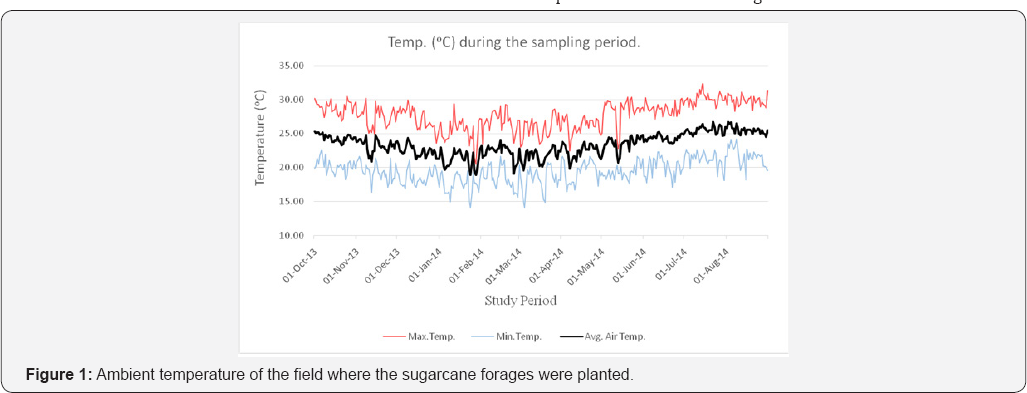

Figure 2
shows the average daily solar load for the field site. This is the
24hour solar load expressed in watts/m2. During the winter months from
Oct. 15th 2013 - March 31, 2014, the average solar load was 170.8+ 3.21 watts/m2. During the summer months from May 15, 2014 - Aug. 31, 2014, the average solar load was 281.26+ 4.68 watts/m2. The summer daily solar load was 110.46watts/m2 higher than the winter solar load.
Influence of temperature and solar load on nutrient composition of forages
These differences in weather data seem to influence nutrient composition of the sugarcane forages, which are C4 plants. Table 1
shows the influence of season (winter vs summer) on nutrient
composition of the forages. The average crude protein (CP) levels were
lower in the summer compared to the winter harvests (8.09 vs. 11.42 %).
Temperature has been known to reduce leaf to stem ratio in Timothy-grass
[4] and Rye-grass [2]. Ohlsson [5]
found that 10 °C increase in temperature can lower digestibility for
Red Clover and Timothy-grass by 5%. A University of Arkansas article on
cool season grasses for hay and silages suggested that for small cereals
and ryegrass, early spring harvest yielded the best forage
characteristics [6]. In the current study, we observed a 3.2% decrease in CP for the summer months (Table 1). Similarly, Beck et al. [7]
reported an 11.4% decrease in CP between November harvest and June
harvest for the cool-season annual grasses. However, Buxton & Fales [8] saw little changes in CP levels. They suggested that each 1 0C increase in temperature would result in a 0.3-0.7 % decrease in digestibility.
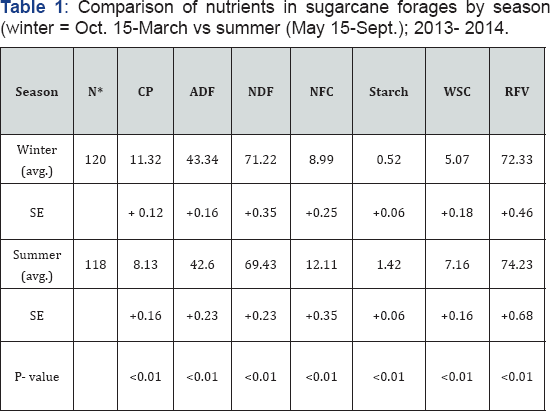
*the lower sample size in summer was due to some
forages inability to recover from the harvest schedule and over time
decreased in yield to the point it was no longer viable to consider
them.
N: Sample Size; CP: Crude Protein; ADF: Acid
Detergent Fiber; RFV: Relative Feed Value; NFC: Non-Fibrous
Carbohydrates; WSC: Water Soluble Carbohydrates
In the current study, we saw the influence of
temperatures on non-fiber carbohydrates (NFC), starch and percent of
water soluble carbohydrates (%WSC). The higher temperatures of summer
months significantly increase the levels of NFC, starch and WSC.
Influence of time of harvest on nutrient composition of forages
(Figure 3)
shows the average nutrient composition of the 40 sugarcane grasses in
the trial. The times of harvest were: a) 830h, b) 1230h and c) 1500h.
The times were selected due to the following reasons: 1) sufficient day
light in the winter months to allow harvesting, sampling, etc. and 2)
consideration given to the research field staff who normally end their
work day by 3pm. Each harvest and sampling took ˜1h 15min. The nutrients
presented in Figure 3 are: a) CP, b) ADF, c) NDF, d) NFC, e) Starch, f) %WSC and g) relative feed value (RFV).
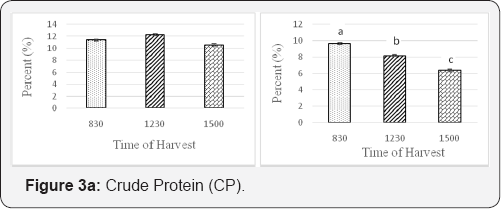
In the winter season, CP was lowest at the 1500h
harvest and highest at 1230h. In the summer months, CP was also lowest
at the 1500h harvest but was highest at the 830h harvest (Figure 3a). Kephart & Buxton [9]
found that imposing shade on forage grasses increased CP values but
that this was often at the expense of yield and soluble carbohydrates.
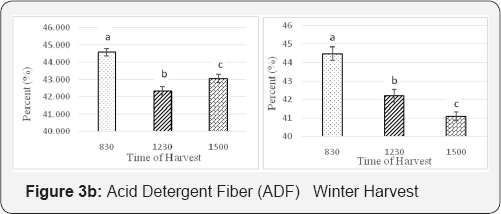
The ADF was highest at 830h harvest for both winter and summer months (Figure 3b).
It was lowest in the harvests past noon. The summer ADF at the 1500h
harvest was the lowest at 41% compared to >44% at the 830h harvest
(p<0.01). The winter months saw the lower NDF at 1230h and 1500h
harvest compared to 830h harvest (p<0.01, Figure 3c).
However, no significant differences were observed in the levels of NDF
in the summer harvest time although the 1230h harvest was the lowest.
Two factors probably played a role in these difference: the rapid growth
rate due to higher ambient temperature and the intense solar radiation
on the plant tissue which may have contributed to the lack of difference
in the NDF observed in the summer harvest.
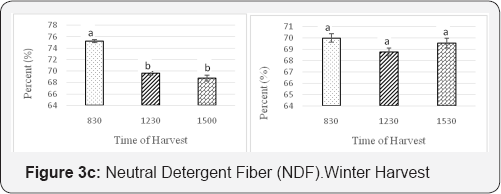
High levels of NDF and/or ADF have negative effect on
dry matter intake. The high levels of NDF increased retention time in
the gut thus contributing the "gut fill” factor [9,10]. Both NDF and ADF contribute to increased chewing time [11,12].
The NFC content for summer (Figure 3d)
showed increasing values with respect to harvest time with the 1500h
harvest having 2x the NFC values compared to 830h harvest (14.83 vs
7.84%. P<0.01). Similarly this was true for the winter harvest where
the 1500h harvest time yielded 2x NFC content compared to 830h harvest
(11.83 vs 6.08 %, P<0.01).
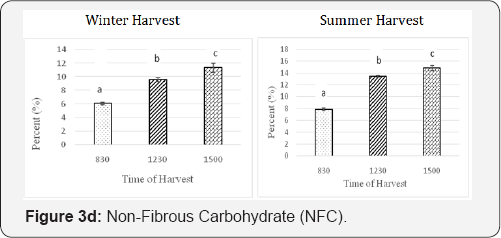

In the winter months, the starch concentrations
increase in the plants over the course of the day. The 1500h harvest had
5x the starch level compared to the 830h harvest; (1.16 vs 0.2,
p<0.01, Figure 3e).
This could be due to the influence of temperature, solar radiation
and/or the genetics of the plant. In the summer months the variations in
the starch concentrations were not as great although a higher level was
observed at the 1500h harvest compared to 830h harvest (1.63 vs 1.31,
P<0.01). The level of starch was higher in the summer month's vs the
winter months. Again this can be attributed to the higher temperatures,
the higher solar load and the genetic makeup of the forage in this
project.
The WSC (%) for winter months reflects that of the starch concentration (Figure 3f).
The 1500h harvest yielded 2x more WSC than the 830h harvest (6.7 vs
2.8%, P<0.01). The WSC levels were very similar at all harvests times
in summer months.
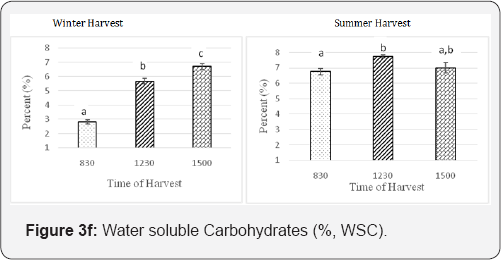
Fermentation of starch and carbohydrates in the rumen
affects the bacteria population and subsequently the flow of microbial
protein to the small intestine [14]. Microbial protein are "by-pass” protein; they provide solid protein for animal growth and milk production. Shenkoru et al. [15]
showed that afternoon (PM) harvested alfalfa yielded higher butyrate
acid and greater microbial nitrogen flow to the duodenum in ruminants
when compared to morning (AM) harvested alfalfa.
Several studies have shown that dry matter intake and
milk yield increased when dairy animals were fed afternoon harvested
feed [16,17]. Kim et al. [16] reported 8% more dry matter intake and 8% more milk. Berthiaume et al. [17]
showed 1.6kg/ day more energy corrected milk and lower milk urea
nitrogen suggesting better utilization of N by the microbes in the
rumen.
The influence of harvest time on carbohydrate
composition has been noted in Switch grass (C4 plant), tall fescue and
alfalfa harvested in the afternoon (PM) vs the morning (AM) [20].
In the study using steers, sheep and goats, the researchers suggested
that the animal showed a preference for afternoon-harvested grass hay.
There was an indication that some animals were able to differentiate the
PM- vs AM-harvested forages by smell. This preference seems to be
associated with the higher concentration of total nonstructural
carbohydrates. In another study, Huntington et al. [19]
concluded that PM-harvested gama grass hay had 7% greater dry matter
intake in goats and 17% greater dry matter intake in steers than
AM-harvested gama grass. They attributed this to the higher total
non-fibrous carbohydrates in forages in the PM harvest. These
observations concurred those reported with alfalfa harvested at sunrise
and sunset [20].
Studies suggest that genetic contribution may enhance
starch and carbohydrates by ˜13% for alfalfa but time of harvest
contributes 46% higher values for these components [21]. Tremblay et al. [22]
demonstrated that PM harvest had higher NSC than AM-harvest for spring,
summer and fall. The higher concentrations of sugars were not affected
during the wilting process.
The above studies may help to explain the earlier
observation that the dairy heifers were going out to graze at
mid-afternoon. The sun and solar radiation might be high but the forages
on the pasture offered the best nutrition due to the photosynthesis.
The plants had low fiber and high sugar and starch contents (high
energy) at that time of the day. Energy is one of the limiting factor
for high milk production or better weight gains. Similar grazing
behavior was observed by Gregorini et al. [23] where dusk grazing was observed to be of greater intensity and duration. Griggs et al. [24]
confirmed higher soluble carbohydrates in PM vs AM forage. This
suggests that cattle are driven to maximize intake based on energy
needs.
The relative feed value (RFV) within a season also showed that PM harvested forages had higher RFV, (Figure 3g).
In the winter months, early harvest at 0830 yielded the lowest RFV
(67.05) compared to the 1500h harvest which had an RFV of 75.05. The RFV
for the forages was 72.15 for the 830h harvest and this value was
higher than that of winter probably due to higher solar and temperature
for the season. The 1500h harvest RFV was 76.25 and this was higher than
the 830h harvest (P<0.01).
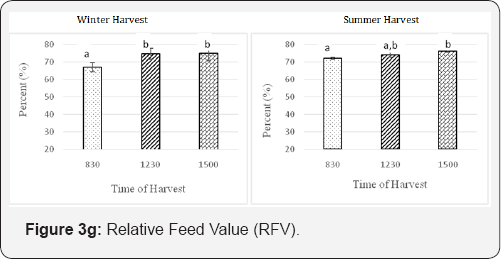
Impact
The cumulative information from this study and others
available in the literature explains why cattle grazed with such
concentration and vigor in the late afternoon. For several years, it was
observed that cattle at the Cloverleaf Dairy in Hawi, Kohahla district,
would go out to the pasture to graze in the mid-afternoon (1430h) when
the heat was intense and the solar radiation load was high during this
time of the day [25].
Yearling dairy heifers in Kohala district compromised their homeostatic
status to feed even when the temperature-humidity index was above 84,Figure 4.
This THI is considered a severe heat stress condition. The grazing
behavior can now be explained by the higher feed value of the forages in
the afternoon. The data further suggest that for those making hay or
bio-fuel from forages, PM harvest will yield higher quality product.
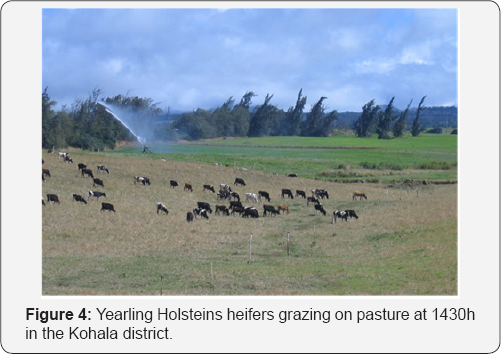
Summary
This study demonstrated that season and time of
harvest can influence the nutrient composition of the forages. The time
of harvest has the greatest influence on the starch, NFC, WSC and ADF
values and all these factors will impact animal performance.
To know more about journal of veterinary science impact factor: https://juniperpublishers.com/jdvs/index.php



Comments
Post a Comment